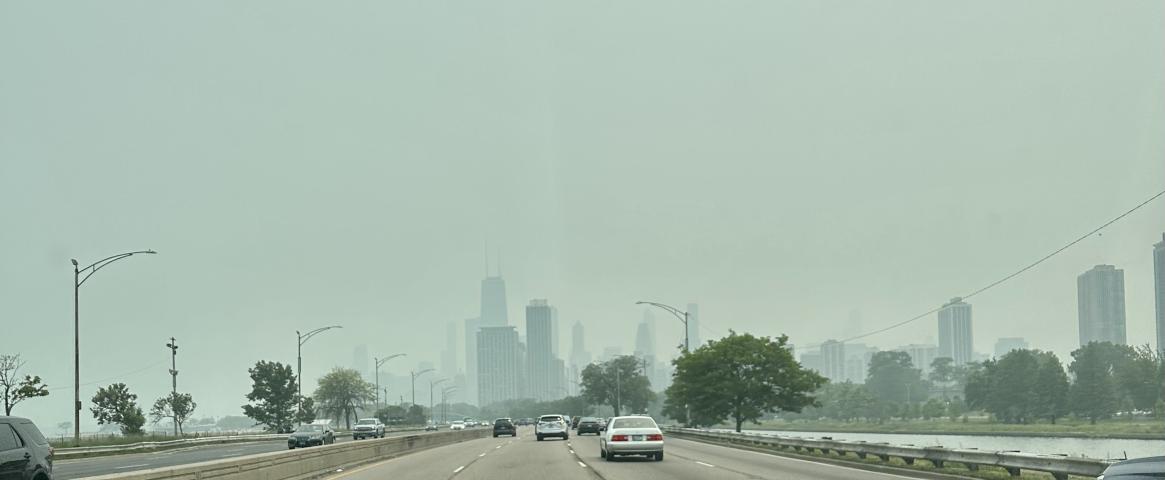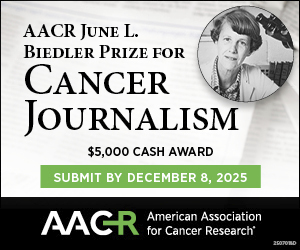This student story was published as part of the 2023 NASW Perlman Virtual Mentoring Program organized by the NASW Education Committee, providing science journalism practice and experience for undergraduate and graduate students.
Story by Sarah Mahaney
Mentored and edited by Shel Evergreen
As Chicago grapples with air pollution, wildfire smoke adds to the burden, leaving low-income communities at a higher risk for air-pollution-related illnesses
Chicagoans awoke on June 27 to find a hazy skyline and the smell of smoke outside their windows. This summer, Canadian wildfire smoke has smothered major U.S. cities, but the effects are not shared equally. Low-income communities are often more vulnerable to poor air quality impacts due to lack of air filtration, proximity to highways, and other clean-air barriers.
Prolonged exposure to wildfire smoke can lead to cardiovascular disease or lung cancer, among other health problems.Wildfire smoke contains fine particulates called PM 2.5, and gasses such as nitrogen oxides and carbon monoxide. These particulates can cause harm when breathed in, as they’re small enough to reach the lungs, heart, and even the bloodstream, according to the EPA.
In addition to causing irritation and shortness of breath, these particulates can aggravate pre-existing health conditions — which low-income people are more likely to have. Children, pregnant women, and adults over the age of 65 are also considered vulnerable to air pollution-related illnesses, according to Shahir Masri, an associate specialist in air pollution exposure assessment and epidemiology at the University of California Irvine.
“During wildfire events, another thing that might render more low-income communities vulnerable is they don’t have the benefit of working remotely,” said Masri. “So, it's harder for them to kind of lockdown, so-to-speak, during a…heavy air pollution event.”
The CDC recommends staying inside and utilizing air conditioning to reduce wildfire smoke exposure. However, this can be difficult for low-income communities and people of color who are more likely to have outdoor occupations or jobs that require onsite work.
Air conditioning is also less common in urban neighborhoods. In 2011, the United States Census Bureau estimated that 30% of Chicago residents do not have air conditioning. Air conditioning circulates and filters air and reduces exposure to outdoor particles, according to the EPA.
Location, location, location
Low-income populations already tend to live in more highly polluted areas, and neighborhoods near highways see a dramatic increase in air pollution exposure.
In a Microsoft-led research project, air quality data collected from over 100 locations around Chicago showed air pollution hot spots in four of Chicago’s low-income neighborhoods: Little Village, Englewood, Austin, and Irving Park/Avondale. All four of these neighborhoods are located west or south of downtown and are near major highways.
In Chicago’s Englewood neighborhood, <a href="https://www.housingstudies.org/data-portal/geography/englewood/#household-income>40.8% of the population lives below the poverty threshold. Englewood's eastern border is marked by I-90 and I-94, and a sensor at the Halsted and 74th intersection had consistently high ratings of air pollution throughout the study. In July 2021, Muckrock and WBEZ analyzed that this sensor averaged roughly 12.5-13 micrograms per cubic meter of PM 2.5. Meanwhile, the sensor at Sheridan and Hollywood in Edgewater only. showed an average of around 9 micrograms per cubic meter of PM 2.5 for the same period. For reference, the national limit for PM 2.5 is 12 micrograms per cubic meters, according to the EPA. Though the World Health Organization advises that PM 2.5 should not exceed 5 micrograms per cubic meter.
The future is hazy
The smoke covering American cities is an example of the worsening effects of climate change and also illustrates how pollution is not beholden to international borders. As average global temperatures rise, communities worldwide are likely to find that wildfire smoke events will become more common.
The source of increased wildfires is linked to high temperatures and drought. A study by Agriculture and Agri-Food Canada found that 60% of the country was abnormally dry in June.
Persistent, multi-year droughts (i.e. megadroughts) increase the risk of severe mega fires (fires burning more than 40,500 hectares). In Canada, there are more than one thousand active fires, and, currently, 676 are “out of control” according to the Canadian Interagency Forest Fire Center.
As these events increase, so do the chances of their disproportionate impacts. Because of this, a spotlight is being placed on politicians in major cities to address these health concerns and provide resources to vulnerable populations. During the first major wildfire smoke event of the summer, New York Mayor Eric Adams received backlash from environmentalists for a “lack of or delayed response.” The New York City Council held a hearing on July 12 to investigate the advocates’ concerns.
"The clouds you see over New York City was a fire thousands of miles away,” Adams said during a press conference. “This is the challenge…there are going to be more issues like this, and there's no blueprint or playbook for these types of issues."
Back in Chicago, Mayor Brandon Johnson said, “The city will continue to provide updates and take swift action to ensure that vulnerable individuals have the resources they need to protect themselves and their families,” in a June 27 statement.
Main image caption: View of downtown Chicago on June 27, 2023. The daily Air Quality Index for particulate matter 2.5 was 209, which is considered “very unhealthy” according to AirNow. Photo: Sarah Mahaney.
Sarah Mahaney is a senior at Loyola University Chicago studying Multimedia Journalism and Environmental Science. She is currently an Editorial Intern with Living on Earth and is the Technical Producer for Rambler Sports Locker, Loyola’s weekly sports broadcast. Connect with her on LinkedIn, X, and view her portfolio! Sarah can be reached at semahaney@gmail.com or smahaney@luc.edu.
The NASW Perlman Virtual Mentoring program is named for longtime science writer and past NASW President David Perlman. Dave, who died in 2020 at the age of 101 only three years after his retirement from the San Francisco Chronicle, was a mentor to countless members of the science writing community and always made time for kind and supportive words, especially for early career writers. Contact NASW Education Committee Co-Chairs Czerne Reid and Ashley Yeager and Perlman Program Coordinator Courtney Gorman at mentor@nasw.org. Thank you to the many NASW member volunteers who spearhead our #SciWriStudent programming year after year.
Founded in 1934 with a mission to fight for the free flow of science news, NASW is an organization of ~ 2,600 professional journalists, authors, editors, producers, public information officers, students and people who write and produce material intended to inform the public about science, health, engineering, and technology. To learn more, visit www.nasw.org




